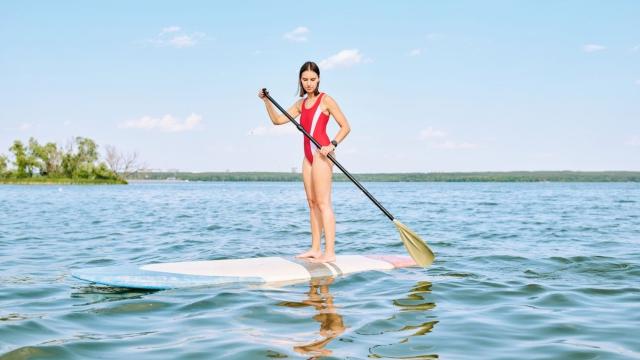Canoes and kayaks are always fun, but the trendiest water sport this summer is stand-up paddle boarding (also known as SUP). It’s lots of fun, relatively easy to learn and can even provide an excellent core workout too. Depending on your skill level, there’s even room for a dog or child to join you at the front, making it a fun activity for the whole family.
Here, we’ve created your ultimate guide to stand-up paddle boarding. See you out on the water!
What is stand-up paddle boarding?
Basically, a paddle board looks like a large surfboard. You propel yourself along with a single paddle that looks like a very long canoe paddle (a blade at the bottom, a handle at the top). You can take a SUP into the ocean and ride some waves or out onto a calm lake or river.
Beginner paddles should opt for a board that’s wide, long and thick. This offers the best stability which allows you to learn the basics without worrying too much about balance. As you become more experienced, you can advance to a smaller paddle board.
Apart from the board, there’s a few other items of equipment you’ll need to invest in. You’ll need a paddle for steering, a SUP leash to attach the board to your ankle and a backpack for personal items. Purchasing a set is the easiest way to grab everything you need at an affordable price.
Where can you buy a paddle board?
Amazon has a great selection of stand-up paddle board sets. The Goosehill Inflatable Board ($649) comes with a backpack, 3-piece paddle, repair kit, SUP leash and triple action pump which makes everything a breeze from start to finish. The DAMA Inflatable Board ($350.57) is a great beginners kit that suits everyone from children to adults.
Many places also sell grip-sole shoes to make standing up even easier. You can grab a pair from Kogan for $62.95.
Top tips
You don’t have to stand up
You can paddle just fine while kneeling or even while sitting cross-legged on the board’s surface. Kneeling is the safest way to approach a dock or any time you’re worried about falling. You can also sit down if you get tired, or just because you feel like it (I find it very relaxing).
You paddle with your whole body
You’ll need to use muscles from your arms and shoulders, through your core, all the way down to your legs. Think about planting the paddle in the water and using your ab and back muscles to pull yourself toward it.
If you learn correct technique, you can paddle on just one side
At first, you’ll take a few strokes on one side and notice you’re veering off course, then switch. Watch a stroke technique video like this one to learn how to stay straight.
Once you get comfortable with stand-up paddle boarding, consider trying paddle board yoga — where, yes, the chance of falling off is a little higher. It can be expensive, because you’re paying for a paddleboard rental and a yoga class, but if you get the chance it’s an experience worth doing. If you want to try it on your own paddleboard, make sure to get an anchor so you don’t drift around the lake.

Comments